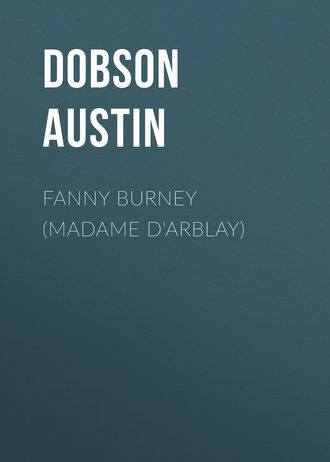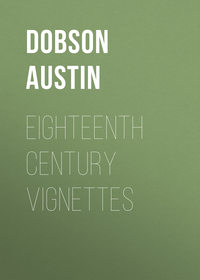 полная версия
полная версияFanny Burney (Madame D'Arblay)
56
Other people think so still. Mr. Bryce (Studies in Contemporary Biography, 1903, i. 127), speaks of Briggs and Miss Larolles as “so exaggerated, as to approach the grotesque.” Nevertheless, as is often the case, Briggs has been more satisfactorily identified with a living model than any other of Miss Burney’s characters. In Mrs. Ellis’s “Preface” and Notes to Cecilia, she shows conclusively that, designedly or undesignedly, Briggs reproduces many of the traits of a personage already mentioned in these pages, Nollekens the sculptor. (See ante, p. 51, and J. T. Smith’s Nollekens and his Times, 2 vols. 1828.)
57
6th December, 1785.
58
There is a large oval print by James Fittler, after George Robertson, dated 28th July, 1783, showing the Queen’s Lodge from the South Terrace, on which the Royal Party are taking their evening promenade. In the background, to the left, at the garden end, the Lower Lodge is to be distinguished. Both Lodges were pulled down in 1823; and their site is now partly occupied by the Royal Stables.
59
In this she probably only slavishly copied her royal Mistress, who (says Miss Burney) “has a settled aversion to almost all novels, and something very near it to almost all novel-writers” (Diary and Letters, 1892, ii. 178).
60
He was, at all events, clever enough to write, in 1798, a Cours Élémentaire d’Histoire Ancienne, a copy of which is exhibited at Kew. It is dedicated to Queen Charlotte, and was intended for the use of the Princesses. On the title-page the author is described as Minister of the King’s French Chapel [in the Middle Court of St. James’s Palace], and Prebendary of Salisbury. He was a married man.
61
Diary and Letters, 1892, ii. 189, 213, 277, 439. Several writers have pointed out this unaccountable lapse in the famous Edinburgh essay on Madame D’Arblay. It may be added that another gift from the Queen, a gold watch set with pearls, is in the possession of Mrs. Chappel of East Orchard, Shaftesbury.
62
Miss Burney probably quoted from memory, as the couplet in the Epilogue to the printed play runs as follows: —
“And oft let soft Cecilia win your praise;
While Reason guides the clue, in Fancy’s maze.”
63
Charlotte Burney was by this time married to Clement Francis, a surgeon practising at Aylsham, about five miles from Windham’s seat at Felbrigge. Mrs. Ellis, quoting from “a family account,” says “Clement Francis had been Secretary to Warren Hastings in India, and while there he read, and was so charmed with Evelina, that he was seized with a desire to make the authoress his wife, and, with that intent, came home from India and obtained an introduction to Dr. Burney and his family, but the result was that he married the younger sister – Charlotte” (Early Diary, 1889, ii. 273 n.).
64
This was by the copious William Combe, author of Dr. Syntax. The full title is —Original Love Letters, between a Lady of Quality and a Person of Inferior Condition, Dublin, 1794, two vols.
65
Not of pity, but of fear. According to his own after-account at Lord Jersey’s table, the King, under some sudden impatience of control, had seized him by the collar, and thrust him violently against the wall.
66
“Upon one occasion he is said to have talked unceasingly for sixteen hours” (Auckland Correspondence, ii. 244, quoted in Jesse’s Life and Reign of George III., 1867, iii. 58).
67
At a later date she puts the matter in a nutshell. “I am inexpressibly grateful to the Queen, but I burn to be delivered from Mrs. Schwellenberg.” She argued, and argued justly, that, unless the desire of further intercourse was reciprocal, she ought only to belong to Mrs. Schwellenberg officially, and at official hours. But “Cerbera” was an old and faithful servant of the Royal Family; and it was obviously difficult to explain the state of affairs to Her Majesty, one of whose objects moreover had been to give Mrs. Schwellenberg a pleasant companion in her old age.
68
This appreciation she never lost. She speaks of herself later as “having resigned royal service without resigning royal favour” (Diary and Letters, 1892, iv. 7).
69
“I have exhausted all the types of character with which I am familiar” – Thackeray told the Rev. Whitwell Elwin in 1856. “I can’t jump further than I did in The Newcomes” (Some XVIIIth Century Men of Letters, 1903, i. 156).
70
Edinburgh Review, January 1843, lxxvi. 557.
71
Sir Joshua Reynolds died on the 23rd February following.
72
One of the tickets given to her by the Queen is preserved by Archdeacon Burney of Surbiton.
73
In an article in the Academy for 15th April, 1871, on the Maclise Gallery in Fraser’s Magazine.
74
Cecilia, it may be mentioned, had been translated at Neuchâtel in 1783.
75
He was, indeed, a better poet than Fanny herself, to judge from some graceful vers d’occasion, printed in the Diary, which he addressed to her on her birthday. The quatrain he placed under her portrait is not so happy.
76
The Girlhood of Maria Josepha Holroyd (Lady Stanley of Alderley), 1897, 2nd edn. pp. 229-30. Mrs. Barrett (Diary and Letters, 1892, iv. 476) puts the income “for a considerable time” at about £125, so that it must have been supplemented in some way.
77
Abdolonime is a gardener of Sidon in a five act comedy by M. de Fontenelle.
78
Mr. E. S. Shuckburgh, in Macmillan’s Magazine for February, 1890, pp. 291-98.
79
Mrs. Ellis thought she detected in Camilla a shaft aimed at the philandering Colonel. “They [men] are not like us, Lavinia. They think themselves free, if they have made no verbal profession; though they may have pledged themselves by looks, by actions, by attentions, and by manners, a thousand, and a thousand times” (Camilla, 1796, iv. 42-3).
80
Lamb’s sonnet was first published in the Morning Chronicle, 13th July, 1820, upon the appearance of Sarah Burney’s tale of Country Neighbours. The author is indebted for knowledge of this poem to the courtesy of Mr. E. V. Lucas, at pp. 82-3, vol. v., of whose very valuable edition of Lamb’s works it is printed. Lamb also addressed a sonnet to Martin Charles Burney, Admiral Burney’s son. It is prefixed to vol. ii. of his Works, 1818. Martin Burney, a barrister, and a dear friend of Lamb, is also mentioned in Elia’s “Detached Thoughts on Books and Reading.” His mother is thought to have been “Mrs. Battle.”
81
For reasons connected with the future tenancy of the house, Mr. Locke’s offer of a site in Norbury Park itself had finally been declined.
82
The house, Camilla Lacey, still exists; but altered and enlarged. When Thorne wrote his Environs of London in 1876, it belonged to Mr. J. L. Wylie, and contained many interesting Burney relics. It is now in possession of Mr. Wylie’s nephew, Mr. F. Leverton Harris, M.P. for Tynemouth.
83
In “A Burney Friendship” (Side-Lights on the Georgian Period, by George Paston, 1902, pp. 31-32), there is an interesting extract from one of Mme. D’Arblay’s letters describing the young Alexandre’s triumphs at “the principal école of Passy.”
84
Moore’s Life of Lord Byron, 1844, 147. Moore corrects this in a note. But it shows that Johnson’s alleged revision of Cecilia must have been current as a rumour long before Macaulay asserted it upon internal evidence in 1843.
85
The arrangement was, that she was to receive £1500 in three payments, spread over a year and a half. If 8000 copies were sold she was to have £3000.
86
She never used this title – as she says in an unpublished letter, dated 26 June, 1827, to her nephew, Dr. C. P. Burney, where she adds to her signature, “otherwise La Comtesse Veuve Piochard D’Arblay” – “because I have had no Fortune to meet it, and because my Son relinquished his hereditary claims of succession – though he might, upon certain conditions, resume them – on becoming a Clergyman of the Church of England. But I have never disclaimed my Rights, as I owe them to no Honours of my own, but to a Partnership in those which belonged to the revered Husband who, for twenty-four years, made the grateful Happiness of my Life.”
87
In the previous year Mme. D’Arblay had lost her brother Charles. James, the Admiral, survived to 1821.
88
See ante, p. 87.
89
Journal of Sir Walter Scott, 1891, i. 308-9. Rogers’ Table Talk, 1858, p. 192, adds a detail of the first visit. Mme. D’Arblay had not heard that Scott was lame; and, seeing him limp, hoped he had not met with an accident. He answered, “An accident, Madam, nearly as old as my birth.”
90
Ibid., ii. 190.
91
Table Talk of Samuel Rogers, 1856, 179-80.
92
“It was not hard fagging that produced such a work as Evelina” – wrote “Daddy” Crisp in 1779 – “it was the ebullition of true sterling genius – you wrote it because you could not help it – it came, and so you put it down on paper.” (Diary and Letters, 1892, i. 178.)
93
These expressions are from Cowper’s Progress of Error, written in 1780-1.
94
Diary and Letters, 1892, iv. 339.




